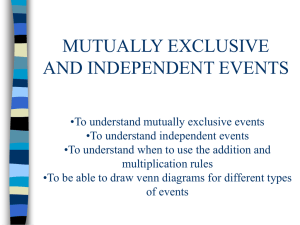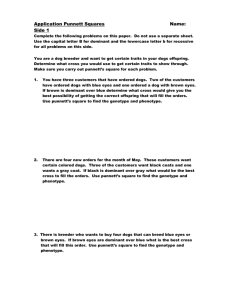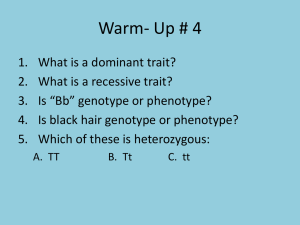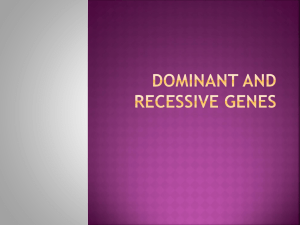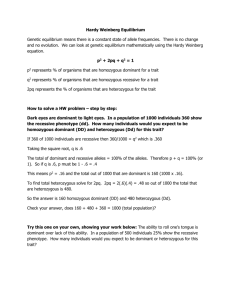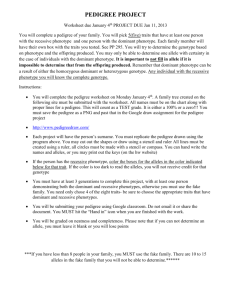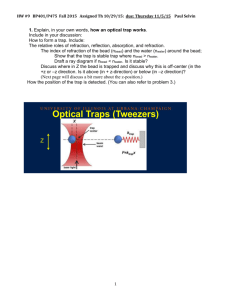The Genetics of BLOOPS
advertisement
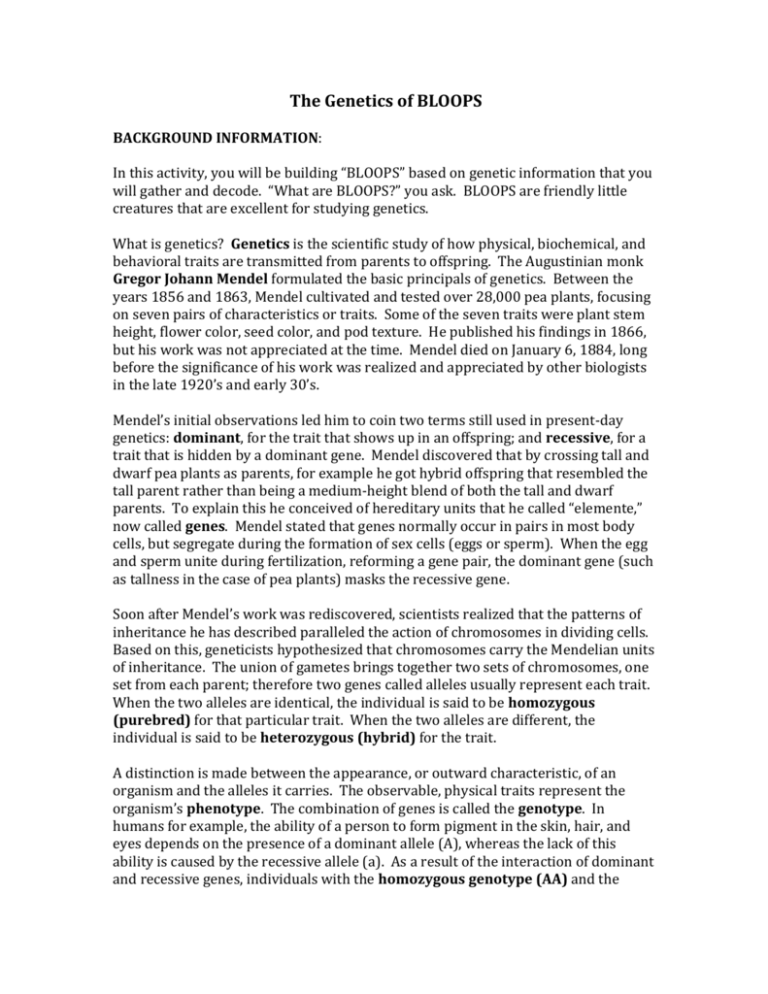
The Genetics of BLOOPS BACKGROUND INFORMATION: In this activity, you will be building “BLOOPS” based on genetic information that you will gather and decode. “What are BLOOPS?” you ask. BLOOPS are friendly little creatures that are excellent for studying genetics. What is genetics? Genetics is the scientific study of how physical, biochemical, and behavioral traits are transmitted from parents to offspring. The Augustinian monk Gregor Johann Mendel formulated the basic principals of genetics. Between the years 1856 and 1863, Mendel cultivated and tested over 28,000 pea plants, focusing on seven pairs of characteristics or traits. Some of the seven traits were plant stem height, flower color, seed color, and pod texture. He published his findings in 1866, but his work was not appreciated at the time. Mendel died on January 6, 1884, long before the significance of his work was realized and appreciated by other biologists in the late 1920’s and early 30’s. Mendel’s initial observations led him to coin two terms still used in present-day genetics: dominant, for the trait that shows up in an offspring; and recessive, for a trait that is hidden by a dominant gene. Mendel discovered that by crossing tall and dwarf pea plants as parents, for example he got hybrid offspring that resembled the tall parent rather than being a medium-height blend of both the tall and dwarf parents. To explain this he conceived of hereditary units that he called “elemente,” now called genes. Mendel stated that genes normally occur in pairs in most body cells, but segregate during the formation of sex cells (eggs or sperm). When the egg and sperm unite during fertilization, reforming a gene pair, the dominant gene (such as tallness in the case of pea plants) masks the recessive gene. Soon after Mendel’s work was rediscovered, scientists realized that the patterns of inheritance he has described paralleled the action of chromosomes in dividing cells. Based on this, geneticists hypothesized that chromosomes carry the Mendelian units of inheritance. The union of gametes brings together two sets of chromosomes, one set from each parent; therefore two genes called alleles usually represent each trait. When the two alleles are identical, the individual is said to be homozygous (purebred) for that particular trait. When the two alleles are different, the individual is said to be heterozygous (hybrid) for the trait. A distinction is made between the appearance, or outward characteristic, of an organism and the alleles it carries. The observable, physical traits represent the organism’s phenotype. The combination of genes is called the genotype. In humans for example, the ability of a person to form pigment in the skin, hair, and eyes depends on the presence of a dominant allele (A), whereas the lack of this ability is caused by the recessive allele (a). As a result of the interaction of dominant and recessive genes, individuals with the homozygous genotype (AA) and the heterozygous genotype (Aa) produce normal pigmentation which is their phenotype, while individuals with the homozygous genotype (aa) lack pigmentation leading to the phenotype albinism. A single letter usually designates alleles; the dominant allele is represented by the uppercase and the recessive allele is represented by the lowercase letter. If you know the genotype of the parents, it is possible to predict the likelihood of an offspring inheriting a particular phenotype. Predicting the likelihood of an offspring’s phenotype involves the concept of probability. Probability means the chance that a given event will occur. Probability is usually expressed as a fraction, percent, or ratio. In genetics, the probability of a particular phenotype appearing in an offspring can be determined by visualizing how the genotypes of the parents might interact to generate the possible genotypes of the offspring. Such interactions are called crosses. Punnett squares charts are often used to show the offspring genotypes that are possible. R. C. Punnett, who devised the chart, was a British mathematician and biologist. Now, complete the Vocabulary Review sheet before you continue. After every member of your lab group has completed the Vocabulary Review sheet, get a lab sheet from Ms. Sullivan. The Genetics of BLOOPS OBJECTIVE: Determine the genotype and phenotype of the BLOOP. MATERIALS: Eye color bead Antennae color bead Tail shape bead Wing bead BLOOP parts PROCEDURE: 1. Copy the following charts into your Science Notebook: DATA TABLE 1: BLOOP Gene Information EYE COLOR Gold Eyes (DOMINANT) YELLOW BEAD= Y ANTENNAE Red Antennae (DOMINANT) COLOR RED BEAD= R TAIL SHAPE Straight Tail (DOMINANT) PURPLE BEAD= S WINGS Wings present (DOMINANT) ORANGE BEAD= W Silver Eyes (RECESSIVE) WHITE BEAD= y Green Antennae (RECESSIVE) GREEN BEAD: r Curly Tail (RECESSIVE) BLUE BEAD= s Wings absent (RECESSIVE) BLACK BEAD= w DATA TABLE 2: BLOOP Gene Information Trait Genes From the Paternal Chromosome (bead color and symbol) Genes From the Maternal Chromosome (bead color and symbol) Genotype Phenotype EYE COLOR ANTENNAE COLOR TAIL SHAPE WINGS Part One: Determining BLOOP’S Genotype: 2. Send one person to the “paternal genes” station. Without looking into the bags, pick one bead from each of the four bags marked “paternal genes.” 3. Send one person to the “maternal genes” station. Without looking into the bags, pick one bead from each of the four bags marked “maternal genes.” 4. Connect the four “paternal” beads in the following order to make a simple BLOOP chromosome: eye color bead, antennae color bead, tail shape bead, wing bead. This represents a chromosome that your BLOOP would inherit from its father. 5. Connect the four “maternal” beads in the following order to make a simple BLOOP chromosome: eye color bead, antennae color bead, tail shape bead, wing bead. This represents a chromosome that your BLOOP would inherit from its mother. 6. Place the two chromosomes side by side, making sure that the beads for each trait line up next to each other. Refer to Table 1 to determine the genotype for each of the four traits represented by the various bead color combinations. 7. In your notebook, fill in the first three columns of Table 2. Part Two: Determining BLOOP’S Phenotype: 1. Based on the genotypes that you generated for each trait in Part One, determine the corresponding phenotype for each trait. Keep in mind that some traits are dominant and some traits are recessive. Fill in the phenotype column in Table 2. 2. Based on the phenotype, obtain the appropriate parts for your BLOOP and begin to assemble. When you have completed your BLOOP, raise your hand to have your BLOOP checked. Part Three: Punnett squares and probability: Humans and BLOOPS follow the same basic rules of genetics. In BLOOPS, green eyes are dominant, while red eyes are recessive. In humans, brown eyes are dominant, while blue eyes are recessive. Juan and Tina have just gotten married. They want to predict the eye color of their future children. Both Juan and Tina have brown eyes and both are heterozygous for their brown eyes. Here’s how they can predict their children’s eye color: 1. In your notebook, draw a box with 4 squares: 2. Using the letters “b” and “B” as the symbols for eye color, write Juan’s two alleles (genes) for eye color across the top of the chart and Tina’s alleles (genes) for eye color along the side of the chart. (See below) 3. Now fill in the four boxes with an allele from each parent. Each box should contain two letters and shows the different combinations of genes that can show up in their children.

